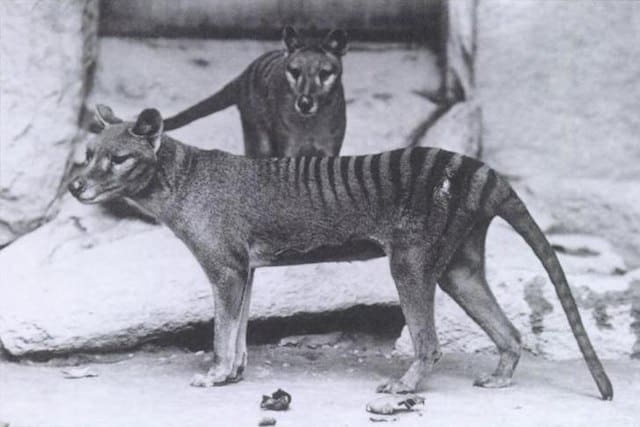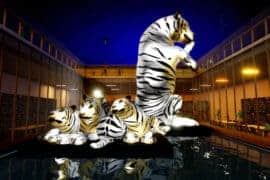Welcome to the Wonderful World of the Thylacine!
Hey there, curious parents and guardians! Are you ready to embark on a fascinating journey through time and nature? Today, we’re exploring the world of an extraordinary creature that has captivated the minds of many: the thylacine, also known as the Tasmanian Tiger. This guide is packed with intriguing facts and thought-provoking points that can help spark a love for natural history in your kids!
What is a Thylacine?
The thylacine, scientifically named Thylacinus cynocephalus, was a large carnivorous marsupial that roamed the forests of Tasmania, Australia, and New Guinea. Its striped back and unique body shape earned it the nickname “Tasmanian Tiger”. Sadly, it’s believed to have gone extinct in the 20th century, but its legacy lives on, reminding us of the importance of conservation and our impact on Earth’s diverse species.
The History of the Thylacine
Let’s jump into our time machine and learn about the history of the thylacine! These creatures were once prevalent across Australia and New Guinea, but their population declined due to a combination of factors such as hunting, habitat loss, and competition with the dingo, another apex predator. The last known thylacine, fondly named Benjamin, passed away in Hobart Zoo, Tasmania, in 1936. However, the story doesn’t end there—numerous sightings and discussions keep the hope of thylacines’ existence alive even today!
Why Should Our Kids Learn About the Thylacine?
Talking to your children about the thylacine is a unique opportunity to introduce them to fascinating topics like extinction, environmental stewardship, and the wonder of the animal kingdom. It’s a way to foster curiosity about nature, the past, and the importance of protecting our world’s ecosystems for future generations.
The Science of Extinction
Understanding extinction is a critical part of learning about the thylacine. It allows us to discuss the delicate balance of our ecosystems and the effects humans can have on other species. We can use the thylacine as a focal point to delve into subjects like biology, ecology, and conservation in a manner that’s engaging and memorable for our kids.
A Lesson in Biodiversity
Biodiversity is the rich tapestry of life on our planet, and the thylacine was a unique thread within it. By studying this extraordinary creature, children can appreciate the vast array of life forms on Earth and grasp the concept of niche species—how each organism has a specific role in its environment.
Values and Ethics in Environmental Conservation
Exploring the story of the thylacine opens the door to conversations about ethics and the importance of taking responsibility for our actions. It exemplifies how vital it is for us to protect endangered species and teaches values such as respect, empathy, and foresight in relation to the natural world.
Inspire a Conservation Mindset
Learning about thylacines can ignite a passion for wildlife conservation in young minds. It can encourage kids to think about future careers in science, environmental policy, or wildlife management. Who knows—you might be nurturing the next leading conservationist in your family!

Five Things Every Parent Should Know When Preparing for Thylacine Exploration
-
Prehistoric Presence and Evolutionary Tale:
Brief your little ones about thylacines’ deep evolutionary roots. Share with them the magnificence of how these mysterious animals were once part of a rich tapestry of wildlife that stretched across prehistoric landscapes. Learning about the evolutionary history offers a window into the past, shaping an understanding of biological diversity.
-
The Importance of Scientific Inquiry:
Ignite curiosity in your children by explaining that science is always evolving. Though the thylacine is classified as extinct, encourage them to consider how scientific advancements might change our understanding in the future. The pursuit of knowledge about the thylacine can inspire careers in science and research, highlighting the importance of never-ending inquiry.
-
Thylacine as an Ecosystem Component:
It’s crucial to emphasize the role the thylacine played in its ecosystem. Discuss with your kids the concept of apex predators and how they help maintain balance within their environments. Understanding the thylacine’s ecological significance can lead to a deeper appreciation for all species’ roles in our world.
-
Human Impact on Wildlife:
Use the thylacine’s story to teach about the consequences of human activity on wildlife populations. Explain how factors like hunting, deforestation, and competition with domestic animals brought these creatures to extinction. It’s a powerful example that highlights the need for sustainable living and animal protection efforts.
-
Conservation Efforts and Hope for the Future:
Finally, it’s essential to communicate the conservation lessons learned from the thylacine’s tale. Discuss ongoing efforts to preserve other species and their habitats. It’s also a chance to include kids in activities like planting trees, learning about recycling, or supporting wildlife charities, fostering a proactive attitude towards conservation.
Now that we’ve covered the essentials for your exploration, let’s delve a bit deeper into what made the thylacine so special and how its legacy can positively impact our children’s perspectives on the environment!
Marvel at the Thylacine’s Unique Biology
Thylacines were not just another carnivore; they had fascinating biological characteristics. From their impressive jaw opening to the pouch both males and females possessed, these features can captivate the imagination of your kids. Highlighting the thylacine’s unique biology emphasizes the wonder to be found in the natural world, reinforcing the idea that every species is worth protecting.
Encourage Questions and Exploration
Children are naturally inquisitive, and questions will abound about the thylacine. Encourage this curiosity! Engage with them by watching documentaries, visiting museums, or even creating art inspired by the Tasmanian Tiger. Every question is an opportunity to learn and grow, and by nurturing this curiosity, you foster a lasting interest in the natural sciences.
Connect with Nature Through Technology
In today’s digital age, use technology to bring the thylacine’s world to life. Utilize apps, online databases, and interactive websites to show lifelike representations of thylacines and their habitats. Virtual and augmented reality experiences can be especially powerful tools in making extinct species feel closer than ever before.
Share Contemporary Stories and Sightings
The intrigue surrounding the thylacine continues, with reported sightings and stories popping up even in recent years. Discuss these tales with your children, examining the reliability of sources and learning about the scientific method in practice. It’s a fun exercise in critical thinking and the pursuit of knowledge.
Visit Local Conservation Programs
Connect with local zoos, wildlife parks, or conservation programs to learn more about the efforts made to protect species from extinction. Many offer educational programs where kids can get a hands-on understanding of what it means to care for our planet’s creatures, driving home the message of the thylacine’s story.
For more great fun click here. For more information see here
Disclaimer
The articles available via our website provide general information only and we strongly urge readers to exercise caution and conduct their own thorough research and fact-checking. The information presented should not be taken as absolute truth, and, to the maximum extent permitted by law, we will not be held liable for any inaccuracies or errors in the content. It is essential for individuals to independently verify and validate the information before making any decisions or taking any actions based on the articles.




